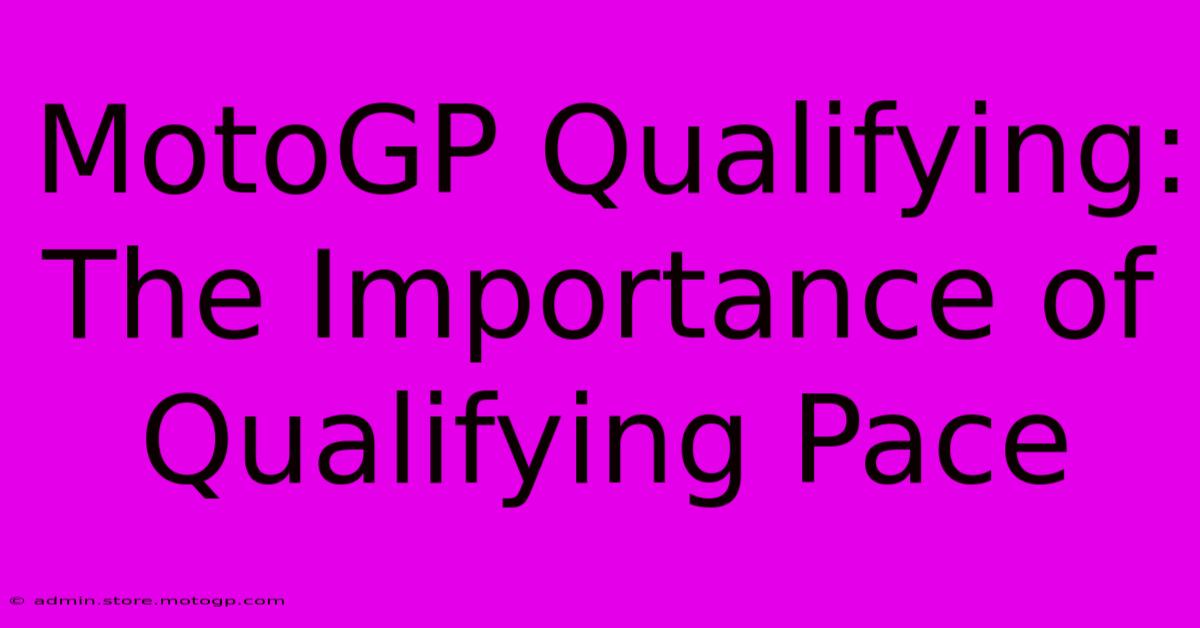MotoGP Qualifying: The Importance Of Qualifying Pace

Table of Contents
MotoGP Qualifying: The Importance of Qualifying Pace
MotoGP racing is a spectacle of speed, skill, and strategy. While the race itself is the ultimate test, securing a strong starting position through qualifying is arguably just as crucial. Qualifying pace, that blistering speed displayed during the limited time allotted for a rider to set their fastest lap, plays a pivotal role in determining race outcome. This article delves into the significance of qualifying pace in MotoGP and explores the factors that contribute to success on Saturday.
The Grid's Influence: Starting Position Matters
The starting grid in MotoGP isn't just a formality; it's a strategic battlefield. A strong qualifying performance translates directly to a better starting position. Consider this:
- Clean Air: Starting near the front guarantees clean air, minimizing the disruption from other riders and allowing for a cleaner racing line. Battling through a congested pack at the start wastes valuable time and energy, often leading to costly mistakes.
- Early Race Advantage: A front-row start allows riders to immediately dictate the pace, set their rhythm, and potentially break away from the competition. This creates a psychological advantage and often makes it more difficult for rivals to close the gap.
- Reduced Risk: Starting further back increases the chances of incidents, such as collisions or getting caught up in crashes in the opening laps. A strong qualifying performance reduces this inherent risk.
- Strategic Opportunities: A good starting position offers riders more strategic options during the race. They can better manage tire wear, fuel consumption, and race tactics based on their comfortable position.
Factors Affecting Qualifying Pace
Several factors combine to determine a rider's qualifying pace:
1. Rider Skill & Technique:
This is the foundational element. A rider's ability to push the bike to its absolute limit while maintaining precision and control is paramount. This includes smooth throttle control, precise braking points, and impeccable cornering techniques. Experience also plays a significant role; veteran riders often have a better understanding of track conditions and how to extract maximum performance.
2. Motorcycle Setup:
The motorcycle's setup plays a crucial role in determining qualifying pace. Engine performance, aerodynamics, suspension settings, and tire selection all contribute to a bike's overall speed and handling characteristics. Teams spend countless hours tweaking these aspects to find the optimal setup for each track and weather conditions.
3. Track Conditions:
Track temperature, humidity, and surface grip significantly influence qualifying pace. A grippy track allows riders to push harder and achieve higher speeds, while a slippery track requires a more cautious approach, potentially sacrificing some speed for safety. Understanding and adapting to changing track conditions is vital for success.
4. Tire Choice & Management:
Tire selection is a crucial tactical decision. The choice between soft, medium, or hard compounds impacts grip and tire degradation. Riders need to carefully manage their tire wear during qualifying to ensure they have optimal performance for the race. Finding the right balance is critical.
5. Team Strategy:
The team's overall strategy during qualifying also plays a part. This involves the timing of pit stops, providing the rider with the necessary information about track conditions and rivals' lap times, and making necessary adjustments to the bike’s setup based on the data collected. Effective team communication is critical.
Conclusion: The Undeniable Importance
Qualifying pace in MotoGP isn't just about setting a fast lap; it's about strategic positioning, risk management, and maximizing the rider's and team's potential. It significantly influences the race outcome, setting the stage for victory or a hard-fought battle from further down the grid. The combination of rider skill, motorcycle setup, track conditions, tire management, and team strategy all intertwine to determine a rider's qualifying success, ultimately showcasing the importance of this crucial phase of a MotoGP weekend.

Thank you for visiting our website wich cover about MotoGP Qualifying: The Importance Of Qualifying Pace. We hope the information provided has been useful to you. Feel free to contact us if you have any questions or need further assistance. See you next time and dont miss to bookmark.
Featured Posts
-
Moto2 Specs Built For Thrills
Feb 20, 2025
-
The Open Road Awaits Cota Track Days
Feb 20, 2025
-
Honda Moto Gp The Art Of Racing
Feb 20, 2025
-
Lot F Cota Myths Vs Reality
Feb 20, 2025
-
Malaysian Motorcycle Grand Prix Where Passion Meets Speed
Feb 20, 2025
